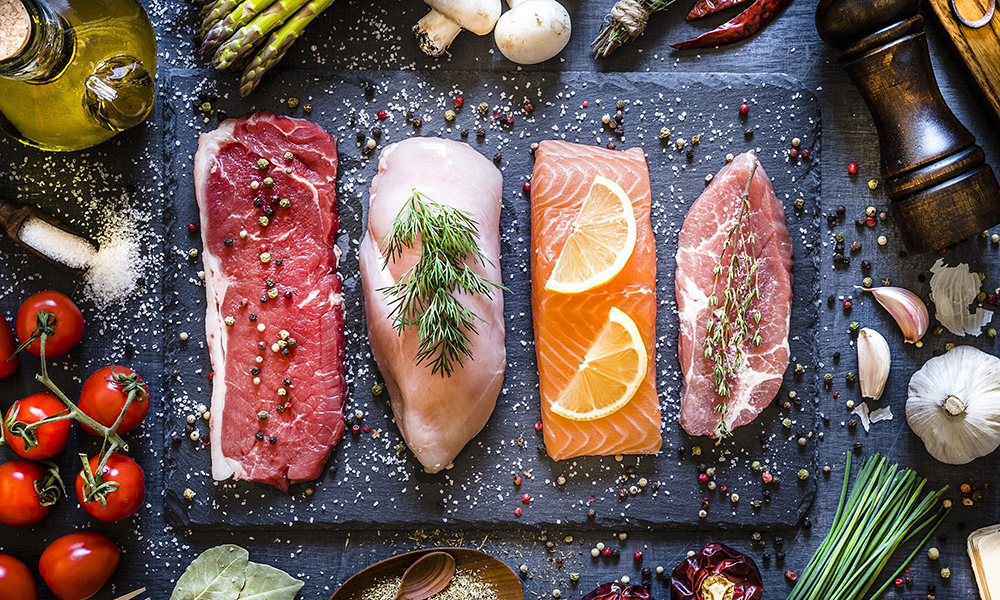 圖片來源:GETTY IMAGES
圖片來源:GETTY IMAGES每周吃一次紅肉可能會大幅提升人們患2型糖尿病的風險。
上述結論源于《美國臨床營養學》(American Journal of Clinical Nutrition)雜志10月19日發布的一項研究。哈佛大學陳曾熙公共衛生學院(T.H. Chan School of Public Medicine at Harvard University)分析了近22萬名參與者橫跨36年的數據。在這一期間,近10%的參與者患上了2型糖尿病。
當研究人員評估了參與者的飲食習慣之后,他們發現,食用紅肉最多的參與者患2型糖尿病的風險比那些不怎么吃紅肉的人高出了62%。
研究人員稱,在每周吃一次紅肉的基礎上,每多吃一次經處理過的紅肉就會讓糖尿病的患病風險增長46%,而且每吃一次未處理的紅肉會讓這一風險再增加24%。
哈佛大學傳染病學與營養學教授沃爾特·威利特博士在有關該研究的新聞發布會上表示:“有鑒于我們的發現以及其他人此前的研究,對那些希望改善其健康和狀態的人來說,合適的做法是將紅肉的食用次數限制在每周約一次。”
其他研究也得出了類似的結論,但并非所有的研究都是如此。哈佛大學和克利夫蘭醫學中心(Cleveland Clinic)2013年的研究發現,如果人們在一段時間的紅肉食用次數增加,那么患2型糖尿病的風險就會水漲船高,部分原因在于食用紅肉會導致體重的增加。
然而,更大的風險可能并非源于肉類本身。2018年的哈佛大學研究發現,如果經常食用使用明火或高溫處理過的紅肉、雞肉或魚(例如燒烤),人們患2型糖尿病的風險要高出1.5倍。
2018年研究的作者稱,這或許是因為高溫加熱可能會產生諸如雜環芳香胺、多環芳香烴以及晚期糖基化終產物,這些都是已知的致癌物,會增加炎癥,降低胰島素敏感性。
富含蛋白質的紅肉替代食物
如果你不知道該吃哪種肉,不妨看看以下大量的備選方案。
美國食品藥物管理局(U.S. Food and Drug Administration)稱,按照2000卡路里的餐食來計算,每人每天應該吃50克的蛋白質。然而,該機構鼓勵人們從不同食物來源攝取蛋白質,并在以下多種食物中進行選擇:
? 菜豆
? 豌豆
? 扁豆
? 蛋
? 低脂或零脂奶制品
? 無鹽堅果和種子
? 大豆制品
? 瘦肉
? 禽肉
? 海鮮
最新研究的作者發現,好消息在于:用堅果或豆類食品來替代每日其中一頓紅肉可將2型糖尿病的患病概率降低30%。選擇從奶制品中攝取蛋白質會讓風險降低22%。
研究人員還稱,對于地球來說:選擇健康的植物蛋白來源而不是紅肉能夠減少溫室氣體排放,并減緩氣候變化。(財富中文網)
譯者:馮豐
審校:夏林
每周吃一次紅肉可能會大幅提升人們患2型糖尿病的風險。
上述結論源于《美國臨床營養學》(American Journal of Clinical Nutrition)雜志10月19日發布的一項研究。哈佛大學陳曾熙公共衛生學院(T.H. Chan School of Public Medicine at Harvard University)分析了近22萬名參與者橫跨36年的數據。在這一期間,近10%的參與者患上了2型糖尿病。
當研究人員評估了參與者的飲食習慣之后,他們發現,食用紅肉最多的參與者患2型糖尿病的風險比那些不怎么吃紅肉的人高出了62%。
研究人員稱,在每周吃一次紅肉的基礎上,每多吃一次經處理過的紅肉就會讓糖尿病的患病風險增長46%,而且每吃一次未處理的紅肉會讓這一風險再增加24%。
哈佛大學傳染病學與營養學教授沃爾特·威利特博士在有關該研究的新聞發布會上表示:“有鑒于我們的發現以及其他人此前的研究,對那些希望改善其健康和狀態的人來說,合適的做法是將紅肉的食用次數限制在每周約一次。”
其他研究也得出了類似的結論,但并非所有的研究都是如此。哈佛大學和克利夫蘭醫學中心(Cleveland Clinic)2013年的研究發現,如果人們在一段時間的紅肉食用次數增加,那么患2型糖尿病的風險就會水漲船高,部分原因在于食用紅肉會導致體重的增加。
然而,更大的風險可能并非源于肉類本身。2018年的哈佛大學研究發現,如果經常食用使用明火或高溫處理過的紅肉、雞肉或魚(例如燒烤),人們患2型糖尿病的風險要高出1.5倍。
2018年研究的作者稱,這或許是因為高溫加熱可能會產生諸如雜環芳香胺、多環芳香烴以及晚期糖基化終產物,這些都是已知的致癌物,會增加炎癥,降低胰島素敏感性。
富含蛋白質的紅肉替代食物
如果你不知道該吃哪種肉,不妨看看以下大量的備選方案。
美國食品藥物管理局(U.S. Food and Drug Administration)稱,按照2000卡路里的餐食來計算,每人每天應該吃50克的蛋白質。然而,該機構鼓勵人們從不同食物來源攝取蛋白質,并在以下多種食物中進行選擇:
? 菜豆
? 豌豆
? 扁豆
? 蛋
? 低脂或零脂奶制品
? 無鹽堅果和種子
? 大豆制品
? 瘦肉
? 禽肉
? 海鮮
最新研究的作者發現,好消息在于:用堅果或豆類食品來替代每日其中一頓紅肉可將2型糖尿病的患病概率降低30%。選擇從奶制品中攝取蛋白質會讓風險降低22%。
研究人員還稱,對于地球來說:選擇健康的植物蛋白來源而不是紅肉能夠減少溫室氣體排放,并減緩氣候變化。(財富中文網)
譯者:馮豐
審校:夏林
Eating more than one serving of red meat per week may significantly increase your risk of developing type 2 diabetes.
That’s according to a study published Thursday in The American Journal of Clinical Nutrition. Researchers from the T.H. Chan School of Public Medicine at Harvard University analyzed health data collected from nearly 220,000 participants over 36 years. During that time, nearly 10% of participants developed type 2 diabetes.
When researchers reviewed participants’ eating habits, they found that those who ate the most red meat had a 62% higher risk of developing type 2 diabetes when compared to those who ate the least amount of red meat.
Beyond one serving of red meat per week, each additional serving of processed red meat came with a 46% increased risk of developing diabetes, and each serving of unprocessed red meat an additional 24% greater risk, researchers found.
“Given our findings and previous work by others, a limit of about one serving per week of red meat would be reasonable for people wishing to optimize their health and wellbeing,” Dr. Walter Willett, a professor of epidemiology and nutrition at Harvard, said in a news release about the study.
Other studies—but not all—have come to similar conclusions. A 2013 study from Harvard and the Cleveland Clinic found that increased red meat consumption over time elevates one’s risk of developing type 2 diabetes—in part because it leads to an increase in body weight.
But there may be more to the risk than the meat itself. A 2018 Harvard study found that people who frequently eat red meat, chicken, or fish cooked over an open flame or high temperature—as you would when you barbecue—had 1.5 times the risk of developing type 2 diabetes.
That may be because cooking meats at high heat can produce chemicals like heterocyclic aromatic amines, polycyclic aromatic hydrocarbons, and advanced glycation end products—all of which are known carcinogens, increase inflammation, or reduce insulin sensitivity, according to the authors of the 2018 article.
Protein-packed substitutes for red meat
If you’re wondering what to eat instead, there are plenty of options.
Everyone should aim to eat 50 grams of protein per day, based on a 2,000 calorie diet, according to the U.S. Food and Drug Administration. But the agency encourages people to vary the sources of their protein, and to choose a variety of the following:
The good news for people: Substituting one daily serving of red meat with nuts or legumes should lower your type 2 diabetes risk by 30%. Consuming protein from dairy sources instead results in a 22% reduced risk, authors of the latest study found.
And for the planet: Choosing healthy plant protein sources instead of red meat reduces greenhouse gas emissions and slows climate change, researchers added.






